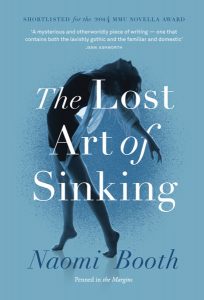 How is it possible to make the subject of asphyxiation for the purpose of pleasure so entertaining? In this novella Booth succeeds in bringing a light touch to an obsession that could be fatal yet without trivialising it. Lines like ‘I did well in my A-Levels. I think de-oxygenation made me especially receptive to Romantic poetry’ had me cackling (p45).
How is it possible to make the subject of asphyxiation for the purpose of pleasure so entertaining? In this novella Booth succeeds in bringing a light touch to an obsession that could be fatal yet without trivialising it. Lines like ‘I did well in my A-Levels. I think de-oxygenation made me especially receptive to Romantic poetry’ had me cackling (p45).
Young Esther who hails from Todmorden where she lives with her father is suffering from ‘mother grief’ when the book opens (p13). The lost art of sinking seems to offer both an escape and something to aspire to. After engaging in the Fainting Game, Esther reports on what fellow schoolgirl Anna McAvoy told her about what she saw before she passed out:
Strange and beautiful shapes; and they were that beautiful, they were what made her go. There were shapes she recognised but didn’t recognise. Like things returning; like ghosts (p17).
From schoolgirls hyperventilating to film star’s swooning to the prospect of erotic asphyxiation, protagonist Esther puts herself in various situations in an attempt to fulfil her craving.
Each chapter explores a different attempt to achieve her ambition, beginning with a short sentence introducing its topic. ‘I suppose you could call it a talent’ (p13) and ‘I should explain about my mother’ (p25). This chatty tone is often delivered direct as though the reader is an old friend or a new lover Esther is confessing to. As such I felt involved in the story and came to empathise with the likable if infuriating Esther.
What at first appears in its ‘covert rushes’ to be a seeking of pleasure is revealed to be closely linked to the aesthetics of performance (p15). Esther often refers to the ‘performance’ she will put on with her fainting, an ambition that echoes her mother’s who was once a lauded ballerina and used to ‘sink and swoon in [her] doomed adagios’ (p33). Here the link is made between swooning and Freud’s death drive. Her mother’s expressed views ally with the ‘lowest… most acephalous drive,’ and how it ‘intersects with the ‘highest,’ most creative and intelligent, in the region beyond the pleasure principle. ‘And I die but still I dance,’ Esther’s mother reports as though her whole life has been sustained in this continual moment of losing consciousness (p33).
For Esther it is not so simple. The theatre of swooning competes with the practicalities of life and she faces many obstacles to attaining her desire. Much of the novella’s humour emerges in her failed attempts at transcendence through drugs or sex and the inconvenient anger of lovers when she tries to turn sexual encounters to her own ends. She has an intuitive sense of what such a performance would mean in practice. ‘A rather tired scenario,’ she speculates, ‘I would be acting out a hammy part’ (p53).
Happily, Esther sabotages her own desires at times. I say happily because I spent the book routing for her to abandon them. As with her mother and many of us, Esther’s destructive impulses mean she misses out on so much life. In exploring the desire to disappear into another state, Booth helps us think about what it means to be conscious as she brings this story to a poignant and suitably ironic ending.
Booth Naomi, 2014. The Lost Art of Sinking. London: Penned In The Margins.
ISSN 1393-614X Minerva – An Internet Journal of Philosophy Vol. 9 2005.
Leave a Reply